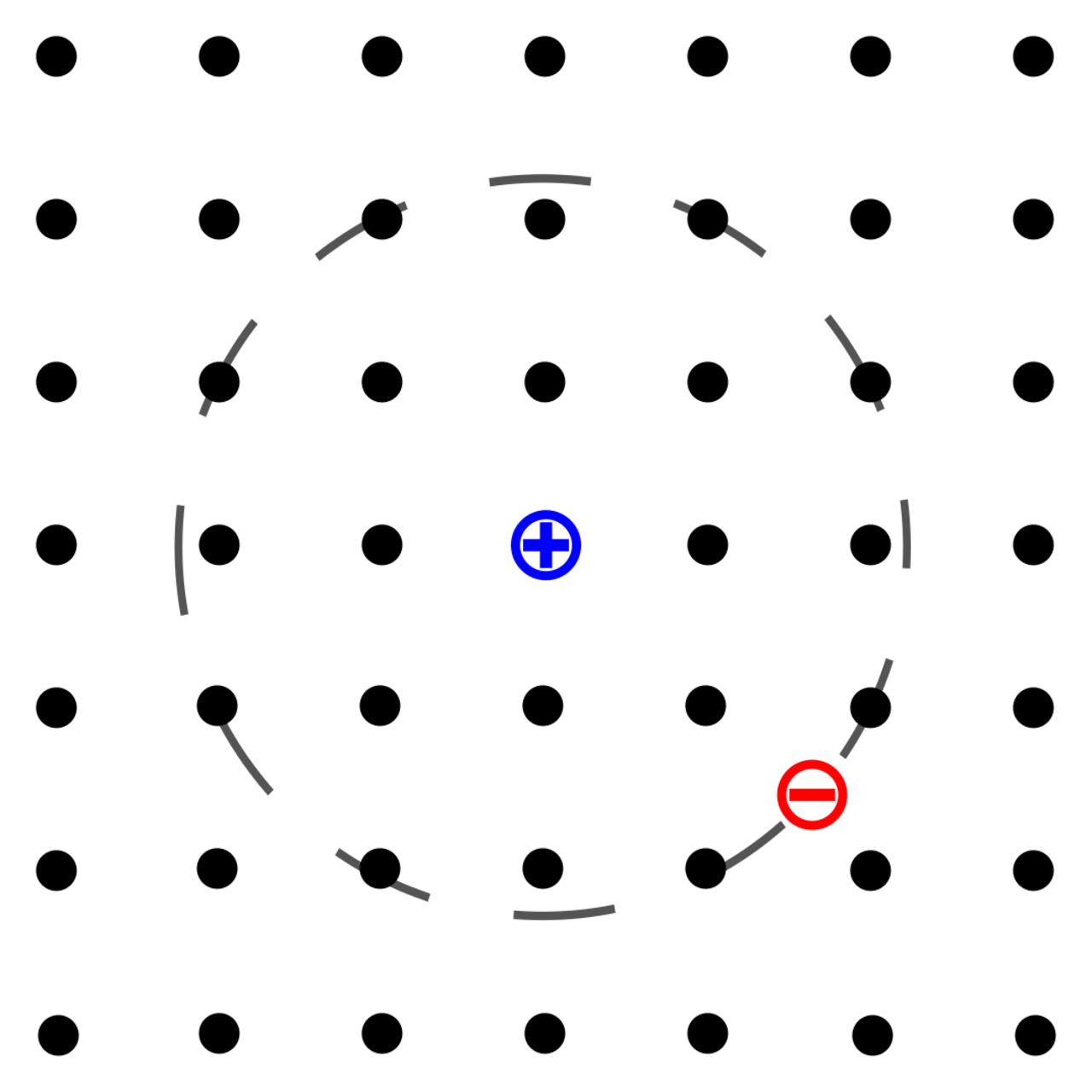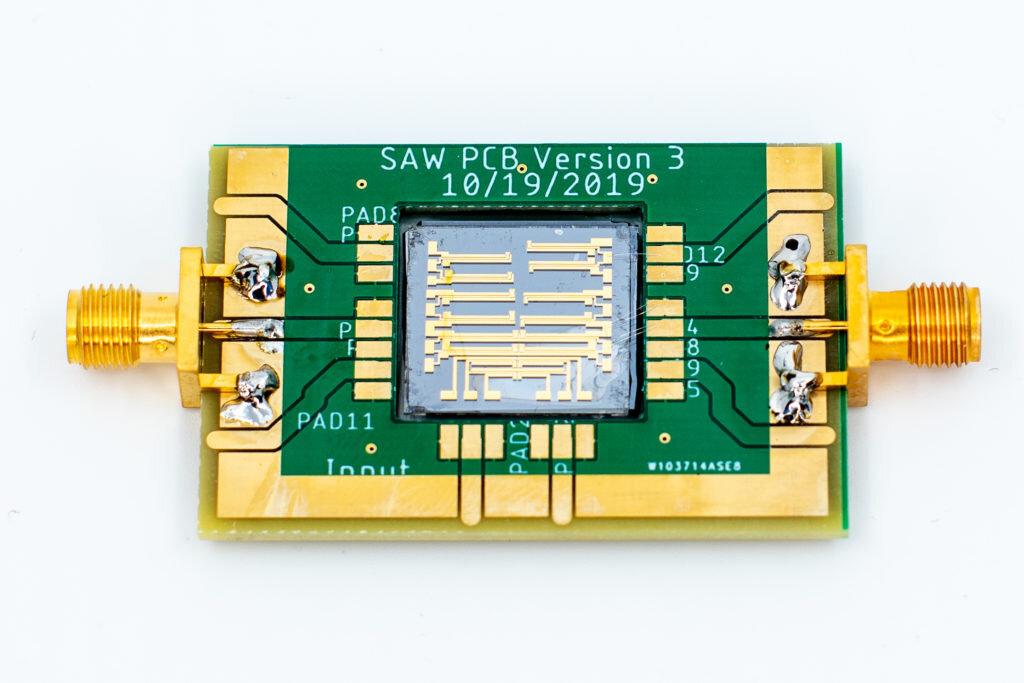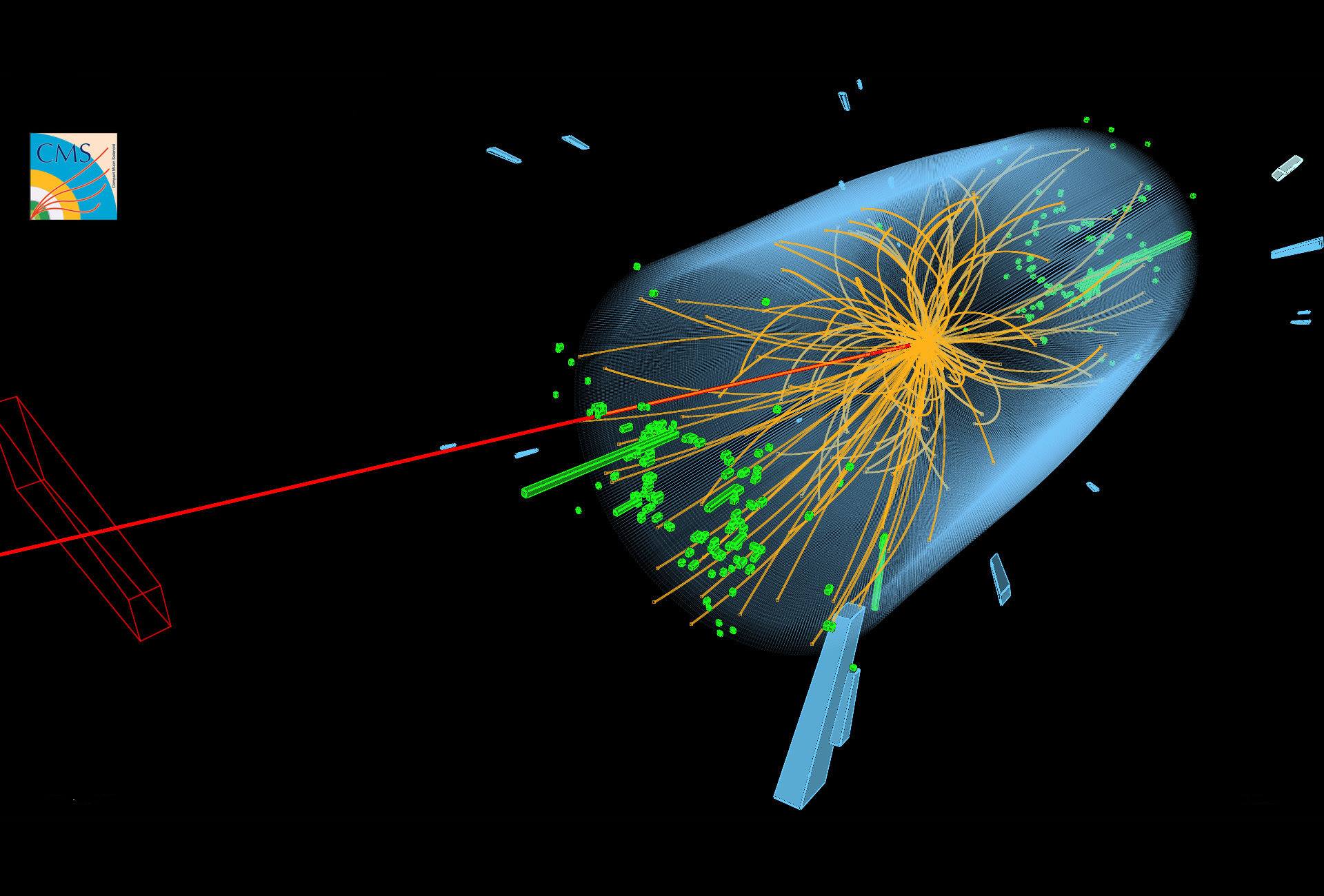
‘Exciton surfing’ could enable next-gen energy, computing and communications tech

A quasiparticle that forms in semiconductors can now be moved around at room temperature, a University of Michigan-led study has shown. The finding could cool down computers, enabling faster speeds and higher efficiencies, and potentially make LEDs and solar panels more efficient.
Today’s electronic devices rely on electrons to move both energy and information around, but about half of that energy is wasted as heat due to electrical resistance. Excitons, which escape traditional electrical losses, are one potential alternative.
“If you think of the past almost two decades, the computers have always been at two to three gigahertz—they never increase the speed. And that’s the reason. It just gets too hot,” said Parag Deotare, assistant professor of electrical engineering and computer science and corresponding author of the study.
“But transistors can go faster if one can remove the excess heat quickly. If you just cut down your communication energy losses, then your processing speed automatically increases. Using excitons can theoretically cut those losses significantly.”
An exciton is a negatively charged electron and a positively charged “hole” that stick together like a single particle. Excitons form when semiconductors absorb light—kicking an electron out of its spot in the semiconductor crystal and creating a hole—as in a solar cell. Or they can be induced through electricity, as in an LED light or perhaps a future computer processor. But because they are charge-neutral, excitons can’t be moved around with differences in electric potential the way electrons can.
The fix demonstrated by Deotare and his team, including collaborators at Japan’s National Institute for Materials Science, is acoustic waves running through the material. They showed that excitons can “surf” these waves, traveling from one location in a semiconductor chip to another. Deotare suggests that controlling excitons in this way could enable data communication, possibly leading to the replacement of the transistor.
“The ability to direct excitons paves the way to exciting future applications that include efficient energy conversion, sensing, detection and room temperature, on-chip excitonic information processing and communication,” said Kanak Datta, a doctoral student in electrical and computer engineering and lead author of the study.
In solar cells, moving excitons out of the relatively thick layer of semiconductor that absorbs photons, or particles of light, and turns them into excitons. If the excitons can be moved to a thin layer before separating the electrons and holes, the energy could be more efficiently converted to electricity.
Similarly, in LEDs, moving excitons could reduce the amount of light lost within the LED. The excitons could be moved away from the electrodes into an area designed for extracting light out of the semiconductor before allowing the electrons and holes to combine and produce a photon.
“Our method offers tunability and flexibility to design exciton transport for particular applications, as well as a manufacturable design,” said Zhengyang Lyu, a doctoral student in applied physics and second author of the paper.
Until recently, attempts at controlling excitons had been relegated to cryogenic temperatures—at room temperature, the electrons and holes quickly fall apart. But new “2D” semiconductors made of single crystal layers changed that—particularly a class of materials known as transition-metal dichalcogenides, a name that describes where the components come from in the periodic table.
Deotare’s group used one of these, tungsten diselenide, to support the excitons. To create the acoustic waves for surfing, they placed that single-layer-semiconductor on a material that stretches and contracts in the presence of an electric field, lithium niobate.
They used a set of electrodes on the lithium niobate to create a waving electric field, which generated the acoustic waves. Because the electric field could split up the electrons and holes that form excitons, the team protected the tungsten diselenide with layers of boron nitride.
“What we’re doing right now will enable us to have a computer that can operate at a much higher speed, consume less energy, and be built at a very small scale,” said Zidong Li, a doctoral student in electrical and computer engineering.
The study is published in Nature Photonics.
Explore further
More information: Kanak Datta et al, Spatiotemporally controlled room-temperature exciton transport under dynamic strain, Nature Photonics (2022). DOI: 10.1038/s41566-021-00951-3

Hoe komt het Higgs-boson aan zijn goddelijke bijnaam?
Wetenschappers vinden de bijnaam belachelijk, het waren de media die de bijnaam ‘god-deeltje’ bedachten voor het Higgs-boson.
Een Canadese wetenschapper van het Europees Centrum voor Kernonderzoek (CERN), zegt een hekel te hebben aan de term god-deeltje. ‘Het Higgs-deeltje heeft geen enkele religieuze betekenis. Het is idioot om hem zo te noemen’. Een Duitse collega noemde de term volledig ongepast. ‘De bijnaam doet geen recht aan het Higgs-boson en aan wat wij denken dat zijn rol is in het heelal. Het heeft niets te maken met God.’
Sterren en planeten
Wetenschappers zijn decennialang op zoek geweest naar het Higgs-deeltje. Het deeltje is volgens het Standaard Model de sleutel voor het ontstaan van sterren en planeten in het heelal, omdat hij verantwoordelijk is voor massa in elementaire deeltjes. Vandaar de bijnaam god-deeltje.
Die naam, in het Engels ‘God particle’, zou volgens onderzoekers voor het eerst gebruikt zijn in 1993. Nobelprijswinnaar Leon M. Lederman schreef een boek over het deeltje, getiteld: ‘The God Particle: If the Universe is the Answer, What is the Question?’
Goddamned Particle
Natuurkundigen beweren dat Lederman tegen vrienden zegt dat hij zijn boek ‘The Goddamned Particle’ (Het godverdomde deeltje) had willen noemen, om uiting te geven aan de frustratie over het niet kunnen vinden van het deeltje. Maar zijn uitgever zou die titel niet hebben geaccepteerd, mogelijk omdat gelovigen het kwetsend zouden kunnen vinden. Hij zou de uiteindelijke titel hebben voorgesteld.
‘Lederman heeft een hoop uit te leggen’, zei de inmiddels bejaarde Britse wetenschapper Peter Higgs, die in de jaren ’60 het bestaan van het veelbesproken deeltje voorstelde.
James Gillies, woordvoerder van het CERN, is meer vergevend over de bijnaam. ‘Het deeltje heeft natuurlijk niets met God te maken’, zegt hij. ‘Maar ik begrijp waarom mensen hem zo noemen. Het Higgs-boson is cruciaal om de natuur te begrijpen.’ https://www.tubantia.nl/wetenschap/hoe-komt-het-higgs-boson-aan-zijn-goddelijke-bijnaam~a9127d8e/?referrer=https%3A%2F%2Fwww.google.nl%2F
Plants that drink from rocks (seite:15)
Sciencewatch C O M P I L E D B Y J O H N S W A I N , NO R T H E A S T E R N U N I V E R S I T Y Some plants are able to live in dry environments by extracting water from the crystalline structure of gypsum, in the absence of any free liquid water. Sara Palacio of the instituto Pirenaico de ecología in Jaca, Spain, and colleagues have shown that the gypsum specialist plant Helianthemum squamatum – a small evergreen shrub that can be found in northeastern Spain, and other places – can draw water from gypsum. The mineral, which is a hydrated form of calcium sulphate (caSo4 • 2 H2O), can also exist as bassanite with a quarter of the water content, or as anhydrite, with no water at all.
The isotopic composition of the crystallization water in gypsum differs from free water, and can be used to show that for shallow-rooted plants, 70–90% of the water taken up comes from gypsum. Details of how the plants extract the crystallization water have yet to be worked out, but it is interesting to note that gypsum is widespread not just on earth, but also on Mars.
● Further reading S Palacio et al. 2014 Nature Commun. 5 4660.
Imaging with undetected photons In a remarkable extension of earlier interaction-free measurement techniques, Gabriela Barreto Lemos of the Austrian Academy of Sciences in Vienna and colleagues have managed to make images using only photons that have not interacted with the object to be visualized. Two separate down-conversion nonlinear crystals are driven with the same pump laser, but creating only one pair of photons. The ambiguity in which crystal produced the photons, together with a rather subtle interferometric set-up, allows an image to be formed entirely using information from photons that are not themselves detected – that is, the photons that illuminate the object are not detected, while those that are detected never illuminated the object. The technique is demonstrated by making images of objects that are opaque or invisible to the photons that are detected.
● Further reading G B Lemos et al. 2014 Nature 512 409.
Reliable teleportation implicit in the now iconic phrase “Beam me up, Scotty!” is the assumption that teleportation should be reliable – something that has only just been achieved. W Pfaff of Delft university in the netherlands and colleagues used two diamond crystals, each with a cryogenically cooled nitrogen-vacancy (nV) as the sender and receiver sites (traditionally called “Alice” and “Bob”). An input qubit is entangled with Alice’s nV, 3 m from Bob’s, with which it was previously entangled by optical means. Before decoherence spoils things – here a few milliseconds – Alice couples her input qubit to her nV, and makes a measurement whose result can then inform Bob (via a classical channel) what to do to his nV to get the original qubit at his end. This is a first for quantum teleportation between distant solid-state (as opposed to photonics) qubits. owing to small imperfections, the actual fidelity was 86%, but in principle could be perfect. now it is just a matter of getting from one qubit up to Avogadro’s number, to make Star Trek fans happy, but in the meantime the technique holds great promise for quantum computing.
● Further reading W Pfaff et al. 2014 Science 345 532.
Searching for (not-so?) intelligent alien life Attempts to detect signatures of alien life have involved looking for atmospheres with molecular oxygen and a reducing gas, but what about intelligent life? Henry Lin of Harvard college in cambridge, Massachusetts, and colleagues have made the amusing – or perhaps depressing – suggestion that exoplanetary atmospheres could be searched for industrial pollutants, such as the chlorinated fl uorocarbons (CFCs) that are damaging our own ozone layer and are unlikely to arise naturally. They estimate that the James Webb Space Telescope could, within a couple of days of observation and at no signifi cant extra cost, check out other worlds, not just for signs of life, but for signs that their residents are dumping around 10 times as much CFCs into their atmospheres as we have done.
● Further reading H W Lin et al. 2014 The Astrophysical Journal Letters 792 L7.
Plants that drink from rocks Helianthemum squamatum. (Image credit: Ghislain118 http://www.fl eurs-desmontagnes.net.) Space dust NASA’s Stardust spacecraft might have brought the fi rst specks of dust from outside the Solar System back to Earth. Andrew Westphal of the University of California, Berkeley, and colleagues, together with 30,714 volunteers worldwide working with Stardust@ home, scanned more than 1 million tracks left in the .1 m2 Stardust Interstellar Dust Collector. The collector, made of ultralow-density aerogel and aluminium, was exposed to the interstellar dust stream coming from the direction of the constellation Ophiuchus for 195 days during two periods in 2000 and 2002. Interstellar dust-particle candidates were distinguished on the basis of composition and/or impact trajectory, rather as in a particle-physics experiment. Seven candidate dust specks were found – one dominated by carbon, another a silicate, and the others more complex. The observations diverge from any one representative model of interstellar dust, leaving the understanding of its nature an ongoing open problem that will take more data to solve.
● Further reading A J Westphal et al. 2014
https://cds.cern.ch/record/1757495/files/vol54-issue8.pdf
Happy Birthday On September 29 it will be exactly 60 years since CERN was founded and started its journey of seeking and finding answers to questions about the universe by studying tiniest fundamental particles.
They built the world’s largest and most sophisticated scientific instrument in order to push the boundaries of human knowledge. The latest and most powerful accelerator is the LHC.
According to CERN’s homepage, thousands of magnets of different varieties and sizes are used to direct the beams around the accelerator. These include 1232 dipole magnets 15 metres in length which bend the beams, and 392 quadrupole magnets, each 5–7 metres long, which focus the beams. Just prior to collision, another type of magnet is used to “squeeze” the particles closer together to increase the chances of collisions.
The particles are so tiny that the task of making them collide is akin to firing two needles 10 kilometres apart with such precision that they meet halfway.
To cool the gigantic cold mass of 37,000 tonnes – the weight of all the magnets together – down to 80 Kelvin, requires 10,000 tonnes of liquid nitrogen. In addition, 130 tonnes of helium are necessary to fill the accelerator. The LHC is not only the largest scientific machine of all time – it is also the biggest refrigerator in the world. And this refrigeration machine is a technical masterpiece.
The ring elements, each 15 metres long and more than a metre thick, shrink by several centimetres during cooling. Special buffers are needed to compensate for this – which is the only way to keep the system absolutely leak-proof. To ensure that the temperature is the same everywhere around the long proton race track, a clever distribution network is necessary for the coolant.
The size of this project and all of the many fascinating solutions are breathtaking. Among those are not only discoveries in the field of fundamental physics. One of the side products, but not less important, is what we today call the world wide web.
After 60 years of pioneering scientific research it’s utterly impossible to enumerate all the exciting discoveries that CERN has made. The detection of the Higgs Boson, for instance, was of enormous importance. The confirmation of this theory was the most important discovery in physics during the last decades. It is one of those historic events which will leave their mark on generations of physicians and influence fundamental research for upcoming decades.
The CERN’s impact on future generations of researchers is impossible to measure as it is to weigh the importance of bringing nations together through science. CERN has set new standards not only in science and technology.
Linde Kryotechnik AG Daettlikonerstrasse 5 8422 Pfungen Switzerland Phone +41.52.304-0555 Fax 41.52.304-0550 E-mail info@linde-kryotechnik.ch Web www.linde-kryotechnik.ch CMS Experiment at the LHC, CERN © 2011 CERN for the benefit of the CMS Collaboration Golden Hadron Award for Linde Kryotechnik AG The dedication of the CERN crew and their exploration of existence have thrilled us again and again.
We are happy to be able to contribute with our helium refrigeration systems. Since the early beginnings of CERN we have been working on cooling the “hot” matters and have played one of the numerous important roles in the complex process of success. We are glad that CERN is pleased with our performance. It still makes us particularly proud that CERN even proved it by presenting us with the Golden Hadron Award for outstanding supplier performance. We are looking forward to upcoming decades of scientific dreams coming true.
